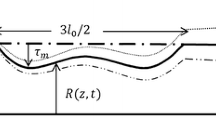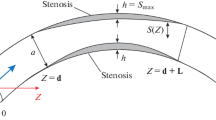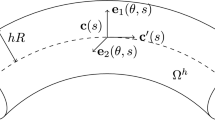Abstract
The flow through a curved tube whose radius of curvature varies with time was studied in order to better understand flow patterns in coronary arteries. A computational flow model was constructed using commercially available software. The artery model featured a uniform circular cross section, and the curvature was assumed to be constant along the tube, and in one plane. The computational model was verified with the use of a dynamically similar in vitro apparatus. A steady uniform velocity was prescribed at the entrance at a Reynolds number of 300. Two sets of results were obtained: one in which the curvature was held constant at the mean, maximum and minimum radii of curvature (quasistatic), and another in which the curvature was varied sinusoidally in time at a frequency of 1 Hz (dynamic). The results of the dynamic analysis showed that the wall shear rates varied as much as 52% of the static mean wall shear rate within a region of 10 tube diameters from the inlet. The results of the dynamic analysis were within 6% of the quasistatic predictions. Realistic modeling of the deforming geometry is important in determining which locations in the coronary arteries are subjected to low and oscillating wall shear stresses, flow patterns that have been associated with atherogenesis. © 1998 Biomedical Engineering Society.
PAC98: 8745Hw, 8710+e
Similar content being viewed by others
REFERENCES
Arteriosclerosis. The National Heart, Lung, and Blood Institute, National Institutes of Health, Report No. 81-2304, 1981.
Austin, L. R., and J. D. Seader. Entry region for steady viscous flow in coiled circular pipes. AIChE. J.20:820-822, 1974.
Batten, J. R., and R. M. Nerem. Model study of flow in curved and planar arterial bifurcations. Cardiovasc. Res.16:178-186, 1982.
Berger, S. A., L. Talbot, and L. S. Yao. Flow in curved pipes. Annu. Rev. Fluid Mech.15:461-512, 1983.
Dean, W. R. Note on the motion of fluid in a curved pipe. Philos. Mag.4:208-223, 1927.
Dean, W. R. The stream-line motion of fluid in a curved pipe. Philos. Mag.5:673-695, 1928.
Delfino, A., J. E. Moore, Jr., and J. J. Meister. Lateral deformation and movement effects on flow through distensible tube models of blood vessels. Biorheology31:533-547, 1994.
Delfino, A., J. E. Moore, Jr., N. Stergiopulos, and J. J. Meister. Residual strain effects on wall stress in a model of the carotid artery. J. Biomech.30:777-786, 1997.
Friedman, M. H., C. B. Bargeron, O. J. Deters, G. M. Hutchins, and F. F. Mark. Correlation between wall shear and intimal thickness at a coronary artery branch. Atherosclerosis (Berlin)68:27-33, 1987.
Friedman, M. H., C. B. Bargeron, D. Duncan, G. M. Hutchins, and F. F. Mark. Effects of arterial compliance and non-Newtonian rheology on correlations between intimal thickness and wall shear. ASME J. Biomech. Eng.114:317-320, 1992.
Gross, M. F., D. B. Vanfossen, and M. H. Friedman. Curvature changes of the left anterior descending coronary artery during the cardiac cycle. In: ASME IMECE Proceedings, Atlanta, edited by S. Rastegar. New York: ASME, 1996, BED Vol. 33.
Grottum, P., A. Svindland, and L. Walloe. Localization of atherosclerotic lesions in the bifurcation of the main left coronary artery. Atherosclerosis (Berlin)47:55-62, 1983.
He, X., and D. N. Ku. Pulsatile flow in the human left coronary artery bifurcation: Average conditions. ASME J. Biomech. Eng.118:74-82, 1996.
Ku, D. N., D. P. Giddens, C. K. Zarins, and S. Glagov. Pulsatile flow and atherosclerosis in the human carotid bifurcation: Positive correlation between plaque location and low and oscillating shear stress. Arteriosclerosis5:293-302, 1985.
Lai, Y. G., A. J. Przekwas, and R. L. Sun. CFD simulation of automotive IC engines with advanced moving grid and multidomain methods. AIAA 24th Fluid Dynamics Conference, Orlando, 1993.
Lai, Y. G., and A. J. Przekwas. A finite volume method for simulation of fluid flows with moving boundaries. AIAA 32nd Aerospace Sciences Meeting, Reno, 1994.
Lee, C. S., and J. M. Tarbell. Influence of vasoactive drugs on wall shear stress distribution in the abdominal aortic bifurcation: An in vitrostudy. Ann. Biomed. Eng.26:200-212, 1998.
Lynch, D. G., S. L. Waters, and T. J. Pedley. Flow in a tube with non-uniform, time-dependent curvature: Governing equations and simple examples. J. Fluid Mech.323:237-264, 1996.
Mark, F. F., C. B. Bargeron, O. J. Deters, and M. H. Friedman. Nonquasi-steady character of pulsatile flow in human coronary arteries. ASME J. Biomech. Eng.107:24-28, 1985.
Moore, J. E., Jr., C. Xu, S. Glagov, C. K. Zarins, and D. N. Ku. Fluid wall shear stress measurements in a model of the human abdominal aorta: Oscillatory behavior and the relationship to atherosclerosis. Atherosclerosis (Berlin)110:225- 240, 1994.
Moore, J. E., Jr., N. Guggenheim, A. Delfino, P. A. Doriot, P. A. Dorsaz, W. Rutishauser, and J. J. Meister. Preliminary analysis of the effects of blood vessel movement on blood flow patterns in the coronary arteries. ASME J. Biomech. Eng.116:302-306, 1994.
Nerem, R. M., and W. A. Seed. Coronary artery geometry and its fluid mechanical implications. In: Fluid Dynamics as a Localizing Factor for Atherosclerosis, edited by G. Schettler. Berlin: Springer, 1983.
Pao, Y. C., J. T. Lu, and E. L. Ritman. Bending and twisting of an in vivocoronary artery at a bifurcation. J. Biomech.25:287-295, 1992.
Pedley, T. J. The Fluid Mechanics of Large Blood Vessels. Cambridge: Cambridge University Press, 1980.
Perktold, K., R. M. Nerem, and R. O. Peter. A numerical calculation of flow in a curved tube model of the left main coronary artery. J. Biomech.24:175-189, 1991.
Perktold, K., and G. Rappitsch. Computer simulation of local blood flow and vessel mechanics in a compliant carotid artery bifurcation model. J. Biomech.28:845-856, 1995.
Sabbah, H. N., F. J. Walburn, and P. D. Stein. Patterns of flow in the left coronary artery. ASME J. Biomech. Eng.106:272-279, 1984.
Santamarina, A. Miami, FL: Florida International University, MS Thesis, 1998.
Schilt, S., J. E. Moore, Jr., A. Delfino, and J. J. Meister. The effects of time-varying curvature on velocity profiles in a model of the coronary arteries. J. Biomech.29:469-474, 1996.
Singh, M. P. Entry flow in a curved pipe. J. Fluid Mech.65:517-539, 1974.
Stein, P. D., M. S. Hamid, K. Shivkumar, T. P. Davis, F. Khaja, and J. W. Henry. Effect of cyclic flexion of coronary arteries on progression of atherosclerosis. Am. J. Cardiol.73:431-437, 1994.
Tang, T. D., D. P. Giddens, C. K. Zarins, and S. Glagov. Velocity profile and wall shear measurements in a model human coronary artery. In: ASME Winter Annual Meeting Proceedings, Atlanta. New York: ASME, 1991, BED Vol. 24.
Author information
Authors and Affiliations
Rights and permissions
About this article
Cite this article
Santamarina, A., Weydahl, E., Siegel, J.M. et al. Computational Analysis of Flow in a Curved Tube Model of the Coronary Arteries: Effects of Time-varying Curvature. Annals of Biomedical Engineering 26, 944–954 (1998). https://doi.org/10.1114/1.113
Issue Date:
DOI: https://doi.org/10.1114/1.113




